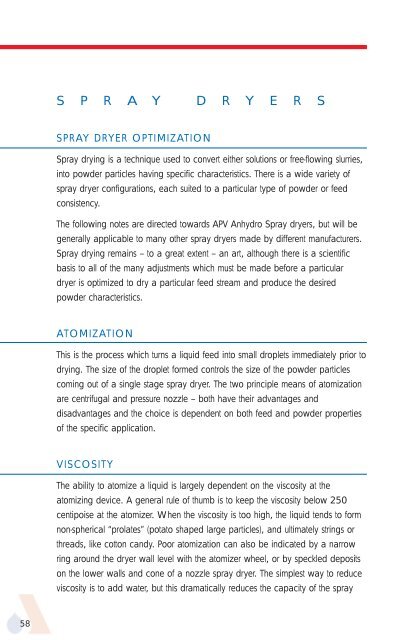APV Dryer Handbook - Umbc
APV Dryer Handbook - Umbc
APV Dryer Handbook - Umbc
You also want an ePaper? Increase the reach of your titles
YUMPU automatically turns print PDFs into web optimized ePapers that Google loves.
58<br />
S P R A Y D R Y E R S<br />
SPRAY DRYER OPTIMIZATION<br />
Spray drying is a technique used to convert either solutions or free-flowing slurries,<br />
into powder particles having specific characteristics. There is a wide variety of<br />
spray dryer configurations, each suited to a particular type of powder or feed<br />
consistency.<br />
The following notes are directed towards <strong>APV</strong> Anhydro Spray dryers, but will be<br />
generally applicable to many other spray dryers made by different manufacturers.<br />
Spray drying remains – to a great extent – an art, although there is a scientific<br />
basis to all of the many adjustments which must be made before a particular<br />
dryer is optimized to dry a particular feed stream and produce the desired<br />
powder characteristics.<br />
ATOMIZATION<br />
This is the process which turns a liquid feed into small droplets immediately prior to<br />
drying. The size of the droplet formed controls the size of the powder particles<br />
coming out of a single stage spray dryer. The two principle means of atomization<br />
are centrifugal and pressure nozzle – both have their advantages and<br />
disadvantages and the choice is dependent on both feed and powder properties<br />
of the specific application.<br />
VISCOSITY<br />
The ability to atomize a liquid is largely dependent on the viscosity at the<br />
atomizing device. A general rule of thumb is to keep the viscosity below 250<br />
centipoise at the atomizer. When the viscosity is too high, the liquid tends to form<br />
non-spherical “prolates” (potato shaped large particles), and ultimately strings or<br />
threads, like cotton candy. Poor atomization can also be indicated by a narrow<br />
ring around the dryer wall level with the atomizer wheel, or by speckled deposits<br />
on the lower walls and cone of a nozzle spray dryer. The simplest way to reduce<br />
viscosity is to add water, but this dramatically reduces the capacity of the spray











